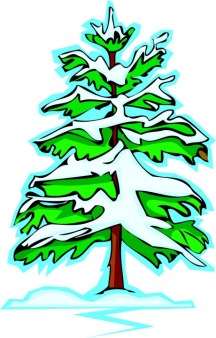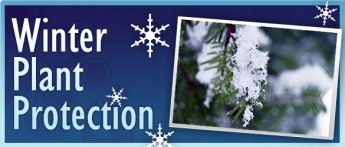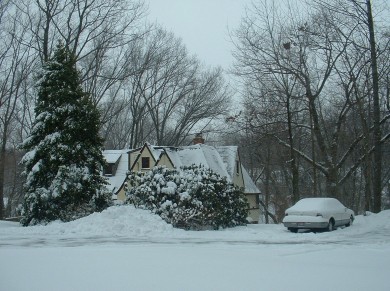As I walked, yes walked to work today, the frigid temperatures of the Arctic Vortex immediately brought the phrase, “crunchy snow, sticky nose” to mind. That’s what I like to call this kind of weather, as the snow “crunches” with each step and my nostrils stick together with each breath. About that walking to work, I should explain. My house and office are adjacent to each other so it’s a very short walk, but it was very cold despite the brevity.
With periods of extreme cold come questions about the impact such temperatures may have on plant materials in the landscape. There are too many variables to be definitive as cold injury varies with plant species, age, general vigor of the plant, and site and soil characteristics. Still, it’s a good time to review potential damage to trees and shrubs, keeping in mind that much of the damage that may occur will not become apparent until spring when new growth begins. By then, many people will have forgotten about the Arctic Vortex, especially if it’s a mild spring, and may not relate plant damage visible in spring to the extreme events of this winter.
Before proceeding further about potential cold injury, there are some critical factors to consider. First, weather conditions this past fall played a part in how plants prepared for winter. In particular, trees & shrubs that have received adequate moisture in the weeks leading up to our first hard frost will be much less likely to suffer cold injury. On the other hand, when a warm period occurs prior to the onset of frigid weather, there is increased potential that physiological changes in plants could result in a reduced tolerance to cold temperature extremes. Remember back to Sunday December 22 when temperatures exceeded 60 degrees?.
 One should also expect that native plant materials in their natural habitats will better tolerate these harsh conditions. The geographic range of native plants is determined by extreme temperatures and not by average temperatures. Having said that, native species planted in our urban / suburban landscapes, where soils and environmental factors are vastly different from their normal habitat, can experience cold injury due to stresses on the plants imposed by these “exotic” habitats.
One should also expect that native plant materials in their natural habitats will better tolerate these harsh conditions. The geographic range of native plants is determined by extreme temperatures and not by average temperatures. Having said that, native species planted in our urban / suburban landscapes, where soils and environmental factors are vastly different from their normal habitat, can experience cold injury due to stresses on the plants imposed by these “exotic” habitats.
Most woody ornamental species used in our northeast Ohio landscapes are non-native species. Hardiness ratings can help one determine the potential survivability of a species in our region of the U.S. However, hardiness zones are determined by average low temperatures for a given region of the country, and not by extreme low temperatures. As such, a species rated hardy to our region may not survive when exposed to extreme temperatures. Keep this in mind when assessing plant problems in the spring.
Snow cover is also an important factor, as it provides natural insulation that can help to protect root systems. Significant root kill will certainly affect the survivability of landscape plants. Soil by itself is a pretty good insulator and in most winters it provides adequate protection for roots. If low temperatures affect roots, it is the “feeder” roots, typically closest to the surface, that will be killed. he amount of damage will depend upon many factors, including the presence or absence of mulch. Snow cover provides an additional blanket of insulation, So, with this Arctic Vortex, in terms of our landscape trees & shrubs, the large snow accumulation is a blessing. 
The roots of plants in above-ground planters or containers are much less protected, and as such are all subject to direct injury or death from the cold.
The amount of cold temperature injury to above ground plant parts is as unpredictable as is the amount of damage to roots. And as with roots, above ground injury will not usually become apparent until spring.
One type of cold injury that is most certain is the killing of flower buds on those trees & shrubs that are marginally hardy in our region. As an example, the flower buds of Forsythia and peaches are prone to winter kill when temperatures drop to minus 15º F, with variances based upon the variety of the plant species or “cultivar” and site factors.
Besides flower buds, the living xylem tissue or most recent annual rings, tend to be less tolerant of cold temperature extremes, particularly the xylem tissue in smaller branches. If damage occurs, affected branches will be slow to leaf and/or flower in spring, or they may die.
Evergreen trees and shrubs are at additional risk as they continue to evaporate moisture due to winter’s drying winds. Frozen soil prevents replacement of this water. “Winter Burn” describes a common injury that occurs on many broad & narrow-leafed evergreens. The results are brown or yellow, sometimes even dead taxus (yew), hollies, and rhododendrons the following spring.
Forest City Tree Protection offers a Winter Protection spray for these plants that can significantly reduce this moisture loss, thereby giving your shrubs and trees an edge against “winter injury.” One application of our winter protection spray in fall lasts through the entire winter, helping to maintain your evergreens’ natural color and protecting foliage from salt damage. For more information about this service contact us at 216-381-1700 or llanphear@forestcitytree.com or go to our website: http://www.forestcitytree.com.
Just remember, this frigid Arctic Vortex weather and the possible kinds of damage that it could cause to plants should be kept in mind when evaluating plant growth or death come spring.
(I’ve adapted this post from an article written by Ron Kujawski of the University of Massachusetts Cooperative Extension.)

